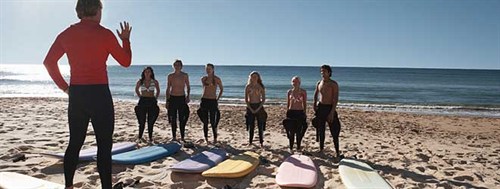
After eons living alongside some of the most spectacular beaches, rivers and lakes in the world, Australians have evolved. If you look closely enough, you'll see our hands and feet are just a little webbed, our eyes bright with the promise of a dip, a snorkel, a dive, a ski or – even on the coldest, windiest day of the year – a surf.
Surfing tips
As a sport, surfing can look daunting to the uninitiated. All long angular boards, danger, extreme levels of fitness and impossibly good-looking people. But ask any surfer and they'll tell you – all it takes to learn to surf is love and respect for the ocean and the waves, reasonable fitness, persistence and most importantly, practice. It also helps to have a few surfing lessons before paddling out on your own.
How to choose a surfboard
There's a massive range of surfboards, with price tags to match. As a rough guide, your basic fibreglass longboard, which is fine for a surfing beginner, will set you back around $300. If you're an opportunist you could even buy a used surfboard for less than $100. At the other end, quality hand-crafted balsa wood boards are $1000 and up; a purchase best delayed until you are no longer eating sand and losing your shorts after every wave.
It is recommended that surfing beginners start with a longboard. At 9-foot plus (that’s 2.7m for the metric minded, though surfboards are often referred to in non-metric measurements), they are very stable and bouyant, meaning you'll catch more waves and be able to ride them longer. Once you've mastered staying on and maneuvering your longboard, you can start experimenting with tricks on a shorter surfboard. A good way to transition to a short board is via a funboard. At 2.1 to 2.4 metres, this is an innovative mix of the best features of the long and short board. Great for both amateurs and professionals, you'll love your funboard so much it may be all you need. Leave the short boards for experienced surfers – they are much more difficult to handle.
Surfing accessories
Accessory-wise, surfing is simple; you need a board bag, board wax, a leg rope (to keep the board in easy reach), and a grip pad for traction, plus a wetsuit or a rashvest (so called because the friction of board and skin can cause a rash). All these can be purchased at a surf shop. Sunscreen and a healthy dose of courage are obvious inclusions. Finally, don't paddle out without good knowledge of the area. Pay attention to weather and surf reports, talk to the lifeguards on duty and other surfers. Respect the knowledge of a lifeguard who advises against surfing in bad conditions and never surf alone.
To find a surf school in your state, plus surf reports and news, check out the Surfing Australia website at www.surfingaustralia.com
Wakeboarding tips: DIY waves
Your frolick in the water doesn't have to be abandoned on the days when surf is elusive. Grab a mate’s boat, load up the wakeboard, and let the thrills begin. A cross between a surfboard and a water ski, the wakeboard is a very cool piece of equipment. As your 'surf' is the wake left by a boat, the experience can be as extreme as you like; it's up to you – or the skipper of the boat!
In order to get a decent swell, the boat needs to reach speeds of 18-24mph. There are specialised wakeboarding boats available, but for the weekend wakeboarder, most runabouts (18 to 24ft) have optional stainless steel or aluminum wakeboarding towers. Placed two metres above the water, this high towing point helps the rider gain height and keep their feet on the board.
Wakeboards are usually constructed of foam mixed with resin and then coated with fibreglass. Like a surfboard you can change your wakeboard fins to suit your skill level and riding style. Many newer models come with molded fins, to which you can add your own configuration. A new board will put you back from around $450 retail, though of course you can buy one for a fraction of this second hand.
Water skiing tips
Invented in Sweden in the mid 1800s (though Americans reckon it's their handiwork), water skiing is a sport that most people will try at least once in their lifetime. Like wakeboarding, the aim of water skiing is to stay upright behind the boat, while balancing on planks. Sounds tricky, and it is at first, but once you work out a technique you'll be hooked.
Originally wood, waterskis are nowadays made from fiberglass or Kevlar. Waterskis come in varying styles, from beginner up to professional, so do your research before you hand over the cash and be honest about your capabilities. It's important to check that the boot fits and is comfortable, and if you are buying secondhand waterskis check for splits, make sure the fins are intact and that the skis are not overly weathered (rubbers, however, can be replaced economically). New skis start at around $500 for beginners’ waterskis, with professional skis well over the thousand dollar mark.
For information on wakeboarding and waterskiing in your state, visit the Australian Waterski and Wakeboard Federation website.www.awwf.com.au